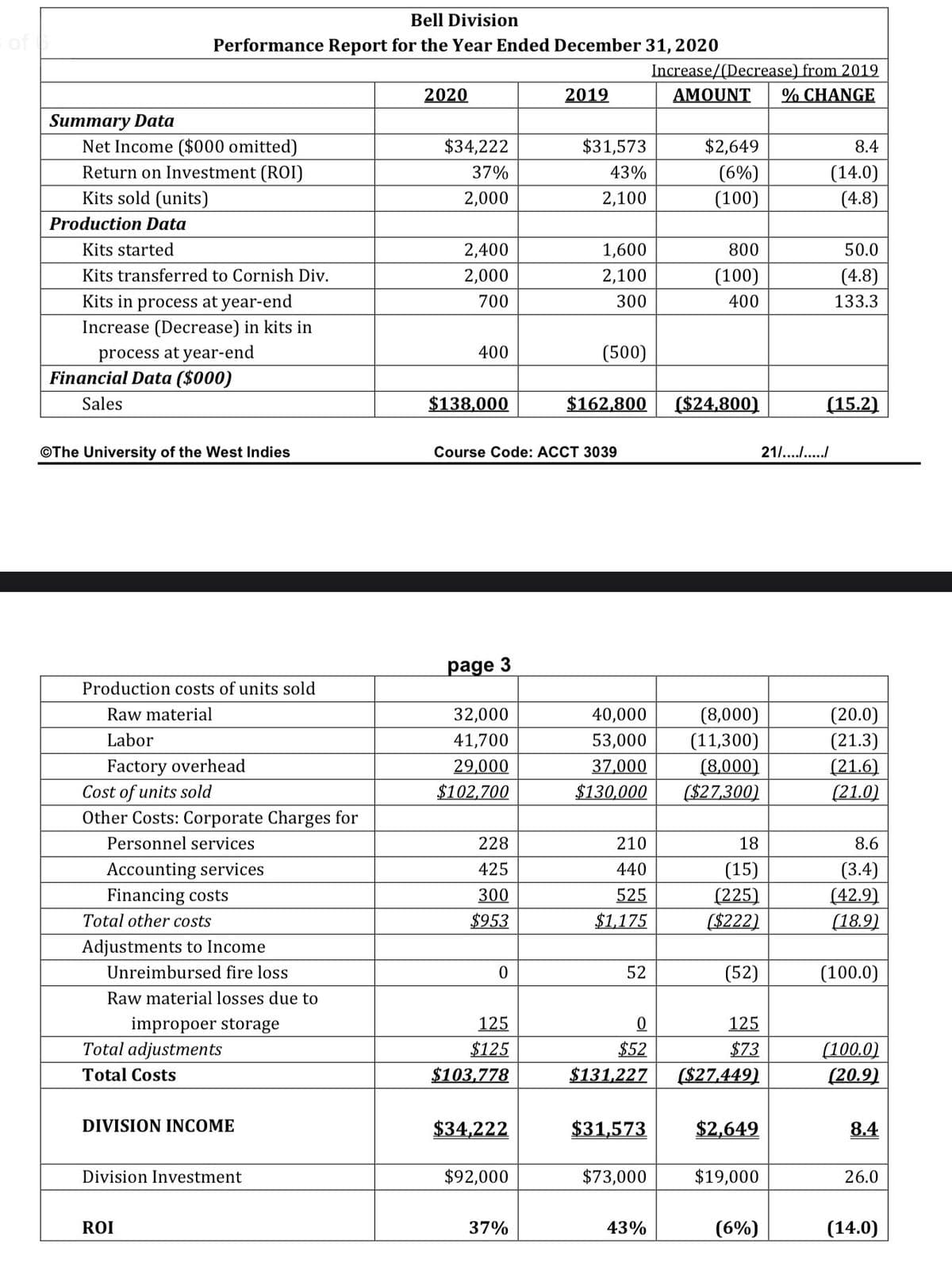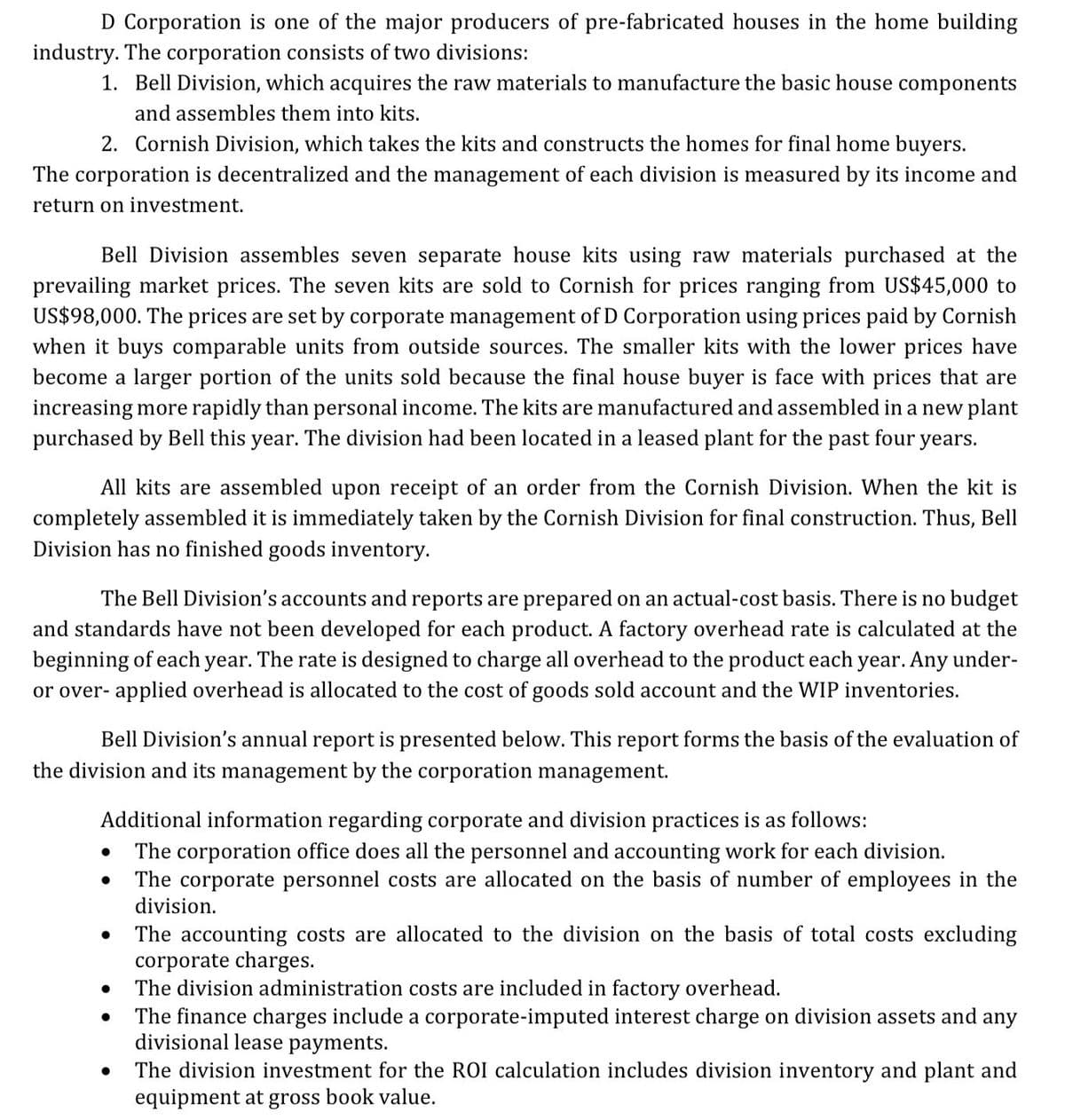1. Discuss whether the manager of Bell Division should be evaluated only on ROI? 2. Provide two (2) reasons why ROI, RI, and EVA may be inappropriate measures of performance.
1. Discuss whether the manager of Bell Division should be evaluated only on ROI? 2. Provide two (2) reasons why ROI, RI, and EVA may be inappropriate measures of performance.
Survey of Accounting (Accounting I)
8th Edition
ISBN:9781305961883
Author:Carl Warren
Publisher:Carl Warren
Chapter11: Cost-volume-profit Analysis
Section: Chapter Questions
Problem 11.4.3MBA
Related questions
Question
1. Discuss whether the manager of Bell Division should be evaluated only on ROI?
2. Provide two (2) reasons why ROI, RI, and EVA may be inappropriate measures of performance.

Transcribed Image Text:Bell Division
Performance Report for the Year Ended December 31, 2020
Increase/(Decrease) from 2019
% CHANGE
2020
2019
AMOUNT
Summary Data
Net Income ($000 omitted)
$34,222
$31,573
$2,649
8.4
Return on Investment (ROI)
(6%)
(14.0)
(4.8)
37%
43%
Kits sold (units)
2,000
2,100
(100)
Production Data
Kits started
2,400
1,600
800
50.0
Kits transferred to Cornish Div.
2,000
2,100
(100)
(4.8)
Kits in process at year-end
Increase (Decrease) in kits in
700
300
400
133.3
(500)
process at year-end
Financial Data ($000)
400
Sales
$138,000
$162,800
($24,800)
(15.2)
©The University of the West Indies
Course Code: ACCT 3039
21/....
page 3
Production costs of units sold
(8,000)
(11,300)
(8,000)
($27,300)
(20.0)
(21.3)
(21.6)
Raw material
32,000
40,000
Labor
41,700
53,000
Factory overhead
Cost of units sold
Other Costs: Corporate Charges for
29,000
37,000
$102,700
$130,000
(21.0)
Personnel services
228
210
18
8.6
Accounting services
Financing costs
(15)
(225)
($222)
(3.4)
(42.9)
425
440
300
525
Total other costs
$953
$1,175
(18.9)
Adjustments to Income
Unreimbursed fire loss
52
(52)
(100.0)
Raw material losses due to
impropoer storage
125
125
(100.0)
(20.9)
Total adjustments
$125
$52
$73
Total Costs
$103,778
$131,227
($27,449)
DIVISION INCOME
$34,222
$31,573
$2,649
8.4
Division Investment
$92,000
$73,000
$19,000
26.0
ROI
37%
43%
(6%)
(14.0)

Transcribed Image Text:D Corporation is one of the major producers of pre-fabricated houses in the home building
industry. The corporation consists of two divisions:
1. Bell Division, which acquires the raw materials to manufacture the basic house components
and assembles them into kits.
2. Cornish Division, which takes the kits and constructs the homes for final home buyers.
The corporation is decentralized and the management of each division is measured by its income and
return on investment.
Bell Division assembles seven separate house kits using raw materials purchased at the
prevailing market prices. The seven kits are sold to Cornish for prices ranging from US$45,000 to
US$98,000. The prices are set by corporate management of D Corporation using prices paid by Cornish
when it buys comparable units from outside sources. The smaller kits with the lower prices have
become a larger portion of the units sold because the final house buyer is face with prices that are
increasing more rapidly than personal income. The kits are manufactured and assembled in a new plant
purchased by Bell this year. The division had been located in a leased plant for the past four years.
All kits are assembled upon receipt of an order from the Cornish Division. When the kit is
completely assembled it is immediately taken by the Cornish Division for final construction. Thus, Bell
Division has no finished goods inventory.
The Bell Division's accounts and reports are prepared on an actual-cost basis. There is no budget
and standards have not been developed for each product. A factory overhead rate is calculated at the
beginning of each year. The rate is designed to charge all overhead to the product each year. Any under-
or over- applied overhead is allocated to the cost of goods sold account and the WIP inventories.
Bell Division's annual report is presented below. This report forms the basis of the evaluation of
the division and its management by the corporation management.
Additional information regarding corporate and division practices is as follows:
The corporation office does all the personnel and accounting work for each division.
The corporate personnel costs are allocated on the basis of number of employees in the
division.
The accounting costs are allocated to the division on the basis of total costs excluding
corporate charges.
The division administration costs are included in factory overhead.
The finance charges include a corporate-imputed interest charge on division assets and any
divisional lease payments.
The division investment for the ROI calculation includes division inventory and plant and
equipment at gross book value.
Expert Solution
This question has been solved!
Explore an expertly crafted, step-by-step solution for a thorough understanding of key concepts.
Step by step
Solved in 2 steps

Knowledge Booster
Learn more about
Need a deep-dive on the concept behind this application? Look no further. Learn more about this topic, accounting and related others by exploring similar questions and additional content below.Recommended textbooks for you

Survey of Accounting (Accounting I)
Accounting
ISBN:
9781305961883
Author:
Carl Warren
Publisher:
Cengage Learning

Cornerstones of Financial Accounting
Accounting
ISBN:
9781337690881
Author:
Jay Rich, Jeff Jones
Publisher:
Cengage Learning

Fundamentals Of Financial Management, Concise Edi…
Finance
ISBN:
9781337902571
Author:
Eugene F. Brigham, Joel F. Houston
Publisher:
Cengage Learning

Survey of Accounting (Accounting I)
Accounting
ISBN:
9781305961883
Author:
Carl Warren
Publisher:
Cengage Learning

Cornerstones of Financial Accounting
Accounting
ISBN:
9781337690881
Author:
Jay Rich, Jeff Jones
Publisher:
Cengage Learning

Fundamentals Of Financial Management, Concise Edi…
Finance
ISBN:
9781337902571
Author:
Eugene F. Brigham, Joel F. Houston
Publisher:
Cengage Learning